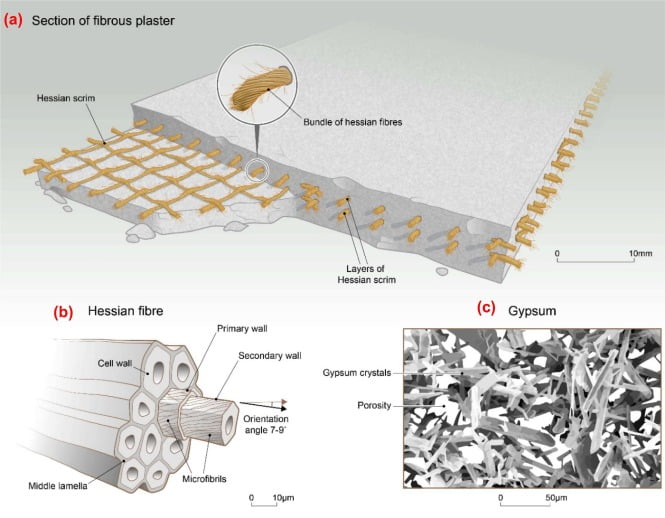Fibrous plaster characteristic
in comparison of gypsum plaster and Fibrous plaster is a type of decorative plasterwork composed of plaster of Paris. That is reinforced with layers of hessian and secured within a timber framework. It is used to produce ornamental elements such as wall friezes, roses, vaulting, and columns. Fibrous plastering is a method used to produce decorative plasterwork on a bench in a workshop. where the casts produced are then taken to the installation site.
The use of fibrous plaster was patented in 1856 and became one of the many architectural innovations of Victorian period. It is well suited for forming pre-cast complex panel shapes such as niches, eccentric vaulting, and serpentine box fronts. Fibrous plaster is often associated with the Victorian and Edwardian theatre and music hall. but it has been employed extensively throughout commercial, cultural, institutional, and high-status residential buildings in the UK.
The material is also used to produce cornices and ceiling roses for the domestic and restoration markets. Fibrous plaster is reinforced with fibers derived from plants and wood wool. grasses, plants like hemp, jute, sisal, and coconut, and wood wool (Aspen and Poplar).

These fibers reinforce the plaster, increasing its tensile strength. The process of fibrous plastering is well suited to contemporary construction. as much of the work can be carried out off-site in the shop. and the moldings and ornament can be affixed to a plaster surface with plaster as the principal adhesive. resulting in a monolithic finish of like materials.
Advantages of using fibrous plaster over other types of plaster
Fibrous plaster offers several advantages over other types of plaster, making it a popular choice for decorative and architectural applications. Some of the key advantages of fibrous plaster include:
Lightweight and Better Reinforced. Fibrous plaster weighs much less than solid plaster and is better reinforced. that is allowing for the preparation of moldings in a studio or on-site prior to installation. thus avoiding the need to run moldings in situ.
Design Flexibility. The use of modular cast moldings allows for a great variety of ornamentation applied in a bespoke way. which is providing flexibility in design and customization.
Superior Finish and Paint Uniformity. Fibrous plaster provides a flatter, even surface, resulting in a superior finish as it takes paint uniformly. making it more forgiving for rooms with natural light or various lighting conditions.
Sound Barrier and Acoustic Comfort. Due to its superior density, fibrous plaster acts as an effective sound barrier, providing better room acoustics. and improves privacy between rooms.
Fire Resistance. The gypsum within fibrous plaster is non-combustible, giving it fire-resistant qualities, which is beneficial for safety. and also regulatory compliance.
Durability and Longevity. Fibrous plaster is hardwearing and long-lasting, providing a timeless and unique look for ceilings and decorative elements.
Thermal and Ecological Benefits. Fibrous plaster, made from plant fibers and plaster, offers thermal insulation and humidity regulation. and also contributing to ecological action and energy efficiency.
Adaptability and Customization. Fibrous plaster can be adapted to any decorative style. which is offering elegance, refinement, and the ability to create designs and styles that suit individual preferences.
Overall, the advantages of fibrous plaster make it a preferred material for interior décor and architectural ornamentation. including its lightweight nature, design flexibility, superior finish, acoustic properties, fire resistance, and ecological benefits.
Disadvantages of using fibrous plaster
The use of fibrous plaster also comes with some disadvantages, including:
Quality of Materials. Historic fibrous plaster may have been produced using poor-quality materials. such as lower quality timber commonly used as lath, which can be prone to issues.
Susceptibility to Damage. The hessian backing of fibrous plaster can be susceptible to neglect, accidental damage, damp, and decay. which can affect its integrity over time.
Complexity of Installation. While fibrous plaster offers design flexibility, its installation can be complex, especially for larger pieces, and may require skilled craftsmanship.
Maintenance. Fibrous plaster may require regular maintenance to ensure its longevity. particularly in terms of addressing any issues related to the hessian backing and other vulnerabilities.
Cost. The production and installation of fibrous plaster may involve higher costs compared to other plastering methods. especially when considering the need for skilled labor and specialized materials.
Weight. Although fibrous plaster is lighter than solid plaster, it still has a certain weight. which may need to be considered in some applications.
While fibrous plaster offers various technical and aesthetic benefits, consider these potential drawbacks when evaluating its suitability for specific projects.

How is fibrous plaster made?
Fibrous plaster is made through a process that involves combining molding plaster with plant fibers. such as hemp, jute, or sisal, to create a strong and lightweight material suitable for decorative applications. The process of making fibrous plaster can be broken down into the following steps:
Preparation of materials. The three main components of fibrous plaster casts are casting plaster, timber laths, and canvas or hessian scrim. The plaster is typically made of gypsum or other binding materials. while the plant fibers provide reinforcement and increase the tensile strength of the plaster.
Molding. The plaster and plant fibers are mixed together to create a paste that can be poured into a mold. The mold is typically made of a material like plaster, silica sand, or gypsum. and is coated with a release agent to ensure easy removal of the cast.
Casting. The plaster mixture is poured into the mold, and the casts are allowed to dry. The timber laths are used to secure the casts in place, and the hessian scrim helps prevent cracking.
Drying and curing. The casts are allowed to dry and cure, which can take several days depending on the humidity and temperature. During this time, the plaster gains strength and becomes less susceptible to damage.
Finishing. Once the casts are dry, they can be finished with paint or other decorative treatments to match the desired aesthetic.
Installation. The fibrous plaster casts are transported to the installation site. and secured in place by fibrous plaster fixers using various methods. such as strong plaster adhesives, mechanical fixings like screws, or wires, brackets, and wads of scrim soaked in plaster.
Fibrous plaster is a versatile material that can be used to create a wide range of decorative elements. such as wall friezes, roses, vaulting, and columns. Its lightweight nature, design flexibility, and fire resistance make it a popular choice for both contemporary and traditional architectural applications.

